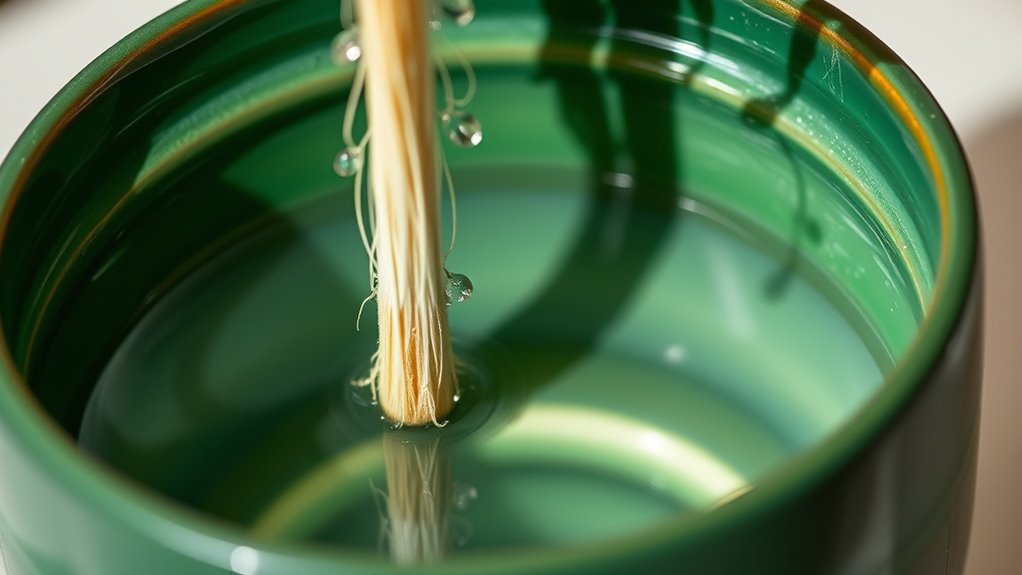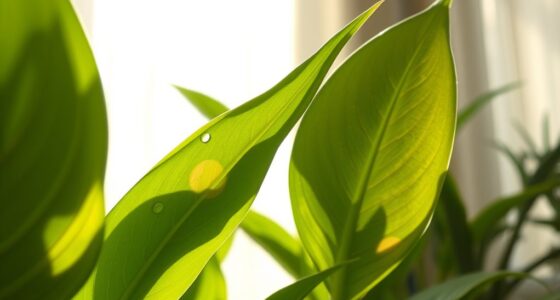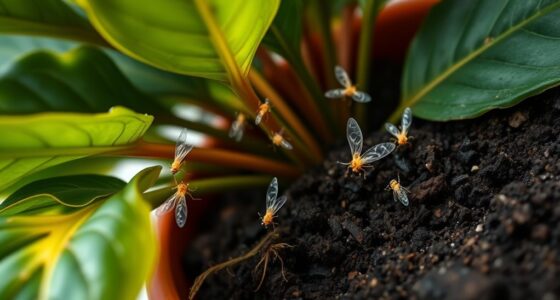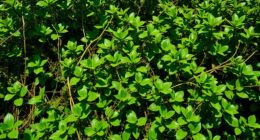Self-watering pots work through capillary action, where a porous wick draws water from the reservoir directly into the soil. This steady supply helps keep your plants consistently moist, reducing over- and underwatering worries. The science shows that choosing the right material and size for your wick, along with well-draining soil, enhances water delivery. If you want to understand how this simple process keeps your plants healthier, there’s more to discover below.
Key Takeaways
- Wicking in self-watering pots relies on capillary action to draw water from the reservoir into the soil.
- The wicking material, such as cotton or nylon, facilitates continuous moisture transfer through capillarity.
- Proper reservoir size and soil composition optimize water delivery and prevent overwatering or drought stress.
- Consistent water supply supports healthier plant growth by maintaining stable moisture levels.
- Scientific principles confirm that effective wicking improves plant vitality and reduces manual watering needs.

If you’re tired of frequently watering your plants, self-watering pots offer a convenient solution. These containers are designed to provide a steady supply of water directly to the plant’s roots, reducing the need for daily watering and helping your plants stay healthy and hydrated. The core mechanism behind these pots involves a wicking system, typically a porous material or a cord, that draws water from a reservoir up into the soil through capillary action. This process guarantees that your plants receive consistent moisture, even if you forget to water them for a day or two.
Understanding the science of wicking can help you choose the right self-watering pot and maximize its performance. The key principle is capillarity, which is the ability of a liquid to flow through narrow spaces without external assistance. In these pots, a wick acts as a bridge between the water in the reservoir and the soil, drawing moisture upward as the plant absorbs water through its roots. This steady supply prevents overwatering and underwatering, two common issues with traditional pots. The wick’s material, often cotton or nylon, plays a vital role; it must be porous enough to allow water movement but also durable to withstand repeated use.
A wick uses capillarity to deliver water, preventing over- and underwatering.
The size of the reservoir influences how long your plants can go without additional watering. A larger reservoir provides a more extended period of moisture availability, making it ideal for busy or forgetful gardeners. Conversely, smaller reservoirs may require more frequent refilling but can be suitable for smaller plants or indoor settings. The soil’s composition also matters—lighter, well-draining mixes work best with self-watering pots because they prevent waterlogging and root rot. Maintaining the wick is simple, but you should occasionally check for clogs or mold, replacing it if necessary to keep the wicking system effective. Moreover, selecting a properly designed self-watering pot can further optimize water delivery and plant health.
Additionally, the science shows that self-watering pots can improve plant health by maintaining ideal moisture levels, which encourages steady growth and reduces stress. Consistent watering prevents the fluctuations that cause stress or disease, making your plants more resilient. Knowing how the wicking process works should give you confidence in these pots’ ability to support your gardening efforts, especially if you’re managing multiple plants or long periods away. Overall, understanding the wicking science reveals that these pots are not just convenient but also a smart way to make sure your plants get the right amount of water at the right time, leading to healthier, happier plants with less effort on your part.
Frequently Asked Questions
How Long Can Plants Survive in a Self-Watering Pot Without Additional Watering?
You can typically leave plants in a self-watering pot for about a week without additional watering, but it depends on the plant type, size, and environment. Thirstier plants or hotter conditions may require more frequent refills, while hardy or drought-tolerant plants can survive longer. Check the water level regularly, and adjust your watering schedule based on your plant’s needs to keep it healthy and thriving.
Are Self-Watering Pots Suitable for All Types of Houseplants?
Self-watering pots are suitable for many houseplants, but not all. You should consider plants that prefer consistent moisture, like ferns or pothos, as they thrive with steady watering. However, succulents and cacti dislike excess moisture and may suffer root rot in these pots. You need to check your plant’s water needs and choose a self-watering pot that matches those requirements for the best results.
How Does the Wick Material Affect Water Delivery Efficiency?
The wick material directly impacts water delivery efficiency by controlling how quickly and consistently water moves from the reservoir to your plant’s roots. Smooth, tightly woven materials like cotton or nylon usually work best, as they draw water steadily without clogging or drying out. Avoid rough or porous materials that can hinder flow or cause uneven watering. Choosing the right wick guarantees your plant stays healthy and well-hydrated.
What Are Common Signs Your Self-Watering System Is Failing?
You’ll notice your plants drooping, like tired soldiers, when your self-watering system starts failing. Water may stop reaching the roots, leaving the soil dry and cracked. You might see algae or mineral buildup on the wick or reservoir, signaling blockages. If the water level remains high or your plants struggle despite watering, it’s time to check your system’s components. Prompt action keeps your plants thriving, not just surviving.
Can Self-Watering Pots Prevent Overwatering and Root Rot?
Yes, self-watering pots can help prevent overwatering and root rot by regulating moisture levels. They deliver water gradually, ensuring your plants get consistent hydration without becoming waterlogged. You’ll notice healthier roots and less risk of rot because the system maintains proper soil moisture. Just make sure you fill the reservoir as needed and check for any blockages to keep the wicking process functioning smoothly.
Conclusion
In short, self-watering pots prove powerful, practical, and perfectly potted for passionate plant parents. By harnessing the helpful harmony of wicking science, you’ll nurture nature’s nuances with ease and excellence. Embrace the effortless efficiency, enjoy the enriching experience, and elevate your environment, all while exploring the elegant elegance of this innovative irrigation. With wisdom and wit, you’ll witness thriving plants and a more tranquil, treasured touch of greenery in your space.










